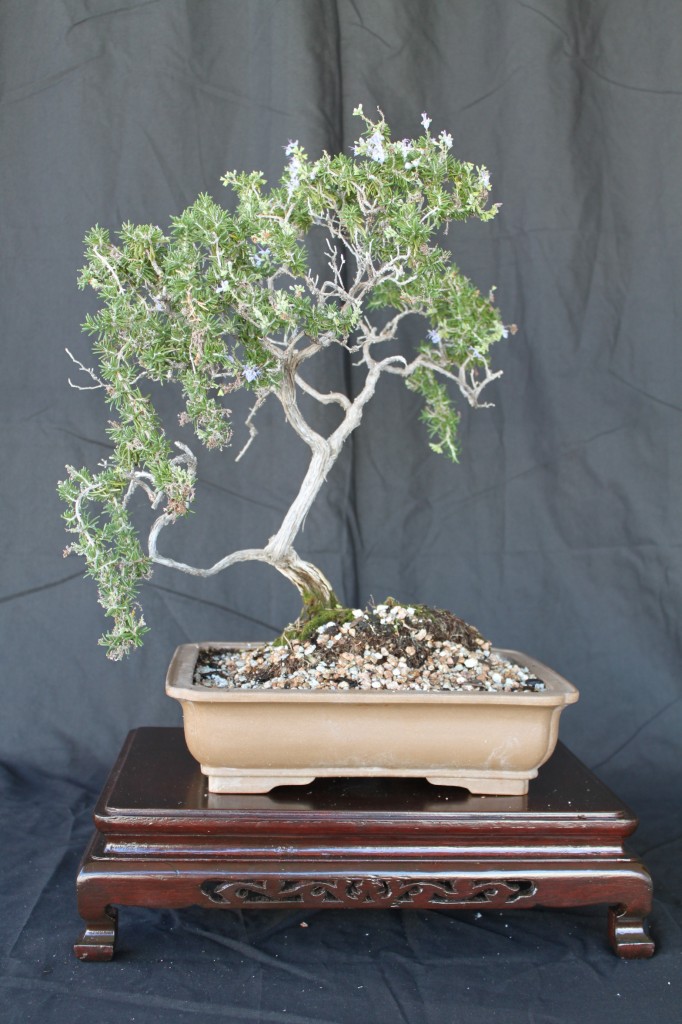Rosemary Bonsai
Rosemary Bonsai
Although not a traditional subject for bonsai, Rosemary works surprisingly well. With tiny leaves, interesting bark, small purple flowers, and a tendency to grow in gnarled, interesting shapes, and the ability to shape and maintain deadwood, Rosemary has all the necessary traits to become a great bonsai.
Background:
Rosemarinus Oficinus, or Rosemary, is a woody evergreen herb native to the Mediterranean and Asia. Since ancient times its leaves have been used for flavoring food, both as an additive, and as a cooking element (i.e. to smoke meat). Rosemary also has significant medical uses. It has also been used as an ornamental plant, and in modern times there are many cultivars. Some are used as ground cover, while others tend to be upright growing and are used as ornamental shrubs or as topiary. In addition to cultivars for shape, some cultivars are grown for their flowers, while others are grown for a specific aroma. While native to Mediterranean climates, Rosemary is winter hardy to some extent (USDA Zone 7). Rosemary produces attractive blue flowers early in the spring, and produces vegetative growth later in the season.
Where to Get One:
In some parts of Europe, Rosemary can be collected from the wild. However, in America, your two options are either to purchase a nursery plant, or collect one from the landscape. Fortunately for collectors, Rosemary tends to form compact root systems. In the wild they take their moisture from the evening dew.
What to Do With It After You Get It:
Rosemary can be thickened in the ground, and the faster growing upright cultivars will form nice prebonsai material in as little as three years. However, they thicken as easily or better in containers, so if you need to build a trunk, then grow a Rosemary as a patio plant in a tub for a few years, then give it the bonsai treatment.
Potting and Soil:
Rosemary prefer loose, fast draining soil, with an organic proportion similar to conifers. 20% organic matter, with the rest aggregate works well. Aggregate can be decomposed granite, coarse sand, pumice, turface, diatomite, fired clay pellets, or any combination of the above. The best time to repot them is early to mid spring, preferably after they have finished flowering. Since Rosemary are capable of sustaining themselves by absorbing moisture through the leaves, they respond very well to fertilizing through diluted foliar feeds. Fertilize in late winter and early spring with a high phosphorus fertilizer to fuel flower growth.
Pruning and Shaping:
Rosemary respond well to pruning, but only cut back to bare wood on a healthy specimen. Rosemary tend to die back as a defense mechanism, just like Junipers, and they can form beautiful natural jins and sharis. On specimens that are not healthy, cutting into bare wood results in diebacks. Only very young growth can be wired. Rosemary tends to form dense, brittle wood, and thick branches cannot be bent.
Styling:
Rosemary works as just about any bonsai style, but the style should suit the cultivar. Some cultivars of Rosemary are natural upright growers and work better in upright styles, while others are naturally prostrate, and work better as semicascade or cascade styles.
Closing Remarks:
If you are a bonsai beginner, and are afraid to work on a Pine, or carve deadwood on a Juniper, Rosemary is a very good alternative. It has needle like foliage, and can be styled similar to Pines and Junipers, and can even sustain deadwood features. The flowers in the spring are an added bonus.

